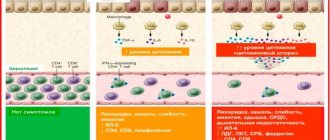Directions for use and doses
Intrathecal administration of vincristine is prohibited.
Vincristine is administered strictly intravenously at intervals of 1 week. The injection duration should be approximately 1 minute.
Before administration, the contents of the bottle are diluted in the supplied solvent with the addition of the required amount of 0.9% sodium chloride solution to obtain a concentration of 0.1 mg/ml.
When administering, care must be taken to avoid extravasation.
The dose is selected individually.
Special instructions for the use of Vincristine
Do not inject into the spinal canal (risk of death). Before starting the injection of vincristine, you must ensure that the needle is inserted strictly intravenously. Penetration of vincristine into surrounding tissues during administration can cause a pronounced inflammatory reaction, including necrosis. In this case, it is necessary to immediately stop the injection and inject the remaining dose into another vein; hyaluronidase can be injected into the site of extravasation of vincristine and a warm compress can be applied, which will improve the absorption of vincristine, reduce discomfort and reduce the risk of an inflammatory reaction from the subcutaneous tissue and connective tissue. Vincristine can cause kidney damage due to the formation of uric acid during massive tumor decay. To prevent such cases, it is recommended to alkalize urine, control the content of uric acid and, if necessary, prescribe inhibitors of its synthesis. Particular attention must be paid to the dosage of vincristine, and also to carefully identify its neurological side effects when prescribed to patients with pre-existing neuropathies or when vincristine is combined with other drugs that have a neurotoxic effect. When combining chemotherapy and radiation therapy with radiation fields that include the liver, the use of vincristine should be delayed until the course of radiation therapy is stopped. Contact of the drug with the eyes should be carefully avoided as it may cause severe irritation and ulceration of the cornea.
special instructions
Intrathecal administration of vincristine can cause death.
During treatment, regular hematological monitoring should be carried out. In case of development of leukopenia, special precautions should be taken when administering repeated doses.
If uric acid levels increase, urine alkalization and uricosynthesis inhibitors are recommended.
If liver function tests increase, the dose of vincristine should be reduced.
The concentration of sodium ions in the blood serum should be determined periodically. To correct hyponatremia, it is recommended to administer appropriate solutions.
Patients with a history of neuropathy are subject to special monitoring.
Vincristine should be prescribed with caution to elderly patients, because their neurotoxicity may be more pronounced.
Any complaints of eye pain or decreased vision require a thorough ophthalmological examination.
Avoid getting vincristine solution into your eyes. If this happens, you should immediately rinse your eyes generously and thoroughly with plenty of liquid.
Vincristine neurotoxicity may impair driving ability.
Overdose
The main symptoms of an overdose of vincristine manifest themselves in the form of increased adverse reactions.
Therapy: symptomatic, should include restriction of fluid intake, therapy with drugs with a diuretic effect (to prevent antidiuretic hormone secretion syndrome), phenobarbital (to prevent the development of seizures), as well as the use of enemas and laxatives (prevention of intestinal obstruction). Monitoring of the cardiovascular system and hematological control is necessary.
Additionally, calcium folinate can be prescribed intravenously at a dose of 100 mg every 3 hours for 24 hours, then every 6 hours for at least two days.
Hemodialysis is ineffective. A specific antidote is unknown.
Vincristine-Teva, instructions for use: method and dosage
Vincristine-Teva solution is administered strictly intravenously (avoiding extravasation) with an interval of 7 days. The duration of the injection is about 1 minute. Intrathecal administration is prohibited.
The dose is determined individually, depending on the treatment regimen and the clinical condition of the patient.
Recommended dosage regimen:
- adults: 1–1.4 mg/m2, single dose – up to 2 mg/m2. The total maximum dose is 10–12 mg/m2;
- children: 1.5–2 mg/m2, initial dose in children weighing ≤ 10 kg – 0.05 mg/kg per week.
Typically the course duration is 4–6 weeks.
If liver function decreases (in patients with direct bilirubin concentration in the blood serum ≥ 3 mg/dl), the dose of Vincristine-Teva is reduced by 2 times.
If signs of severe damage to the nervous system appear, especially with the development of paresis, vincristine should not be used. After Vincristine-Teva is discontinued, neurological symptoms disappear, treatment can be resumed at a dose reduced by half from the initial one.
Pharmacological properties of Vincristine
Vincristine sulfate belongs to the group of alkaloids and is synthesized from a plant known as rose periwinkle (Vinca rosea). The substance has the ability to reversibly block mitosis, that is, the process of division of somatic cells of the body, in the metaphase of the cell life cycle. In high doses, it also suppresses the processes of nucleic acid and protein synthesis. In particular, its mechanism of action is associated with the blockade of tubulin, a protein that is the basis of intracellular structures that make up the cytoskeleton.
According to the instructions, Vincristine has a pronounced cytostatic effect and is capable of provoking necrosis of cancer cells - damaging the membrane, core and other components that form the cell, which, in turn, provokes its death.
Rapidly dividing cells, and in particular those that make up malignant tumors, exhibit the greatest sensitivity to the action of cytostatic drugs.
Healthy cells, characterized by the ability to rapidly divide, are also somewhat less sensitive to the cytostatic effect of Vincristine. This especially applies to cells of the bone marrow, skin and its appendages (hair, for example), as well as mucous membranes.
Due to the ability of cytostatics, including Vincristine, to prevent the growth of body tissues (or, in other words, proliferation), they are widely used in the treatment of autoimmune diseases.
Indications for use
- acute leukemia;
- Hodgkin and non-Hodgkin lymphomas;
- Wilms tumor;
- rhabdomyosarcoma;
- neuroblastoma;
- myeloma;
- Kaposi's sarcoma;
- sarcomas of bones and soft tissues;
- small cell lung cancer;
- choriocarcinoma of the uterus;
- brain tumors.
Vincristine is also used for idiopathic thrombocytopenic purpura (with resistance to corticosteroid drugs and failure of splenectomy).
Drug interactions
Vinca alkaloids are metabolized by the cytochrome P450 isoenzyme CYP3A4. Therefore, when combined with CYP3A4 inhibitors, including itraconazole, ritonavir, ketoconazole, nelfinavir, erythromycin, nefazodone, fluoxetine, the plasma concentration of vincristine in the blood may increase.
Vincristina-Teva should not be mixed with other solutions in the same syringe.
During radiotherapy, the peripheral neurotoxicity of vincristine may increase.
Due to possible suppression of immune system function associated with the use of Vincristine-Teva, the formation of antibodies in response to the vaccine may be reduced. If a live viral vaccine is administered during the treatment period, the production of antibodies may decrease, the replication process of the vaccine virus may intensify, and its side/adverse effects may increase.
Other possible interactions when used in combination with vincristine:
- itraconazole: neuromuscular disorders may develop more rapidly and/or be more severe, which is likely due to inhibition of vincristine metabolism;
- phenytoin: its content in the blood may decrease, which accordingly leads to a decrease in its anticonvulsant effect;
- other myelosuppressive drugs and prednisolone: possible increased inhibition of bone marrow hematopoiesis;
- ototoxic and neurotoxic drugs (itraconazole, isoniazid, nifedipine): against the background of combined use with ototoxic and neurotoxic drugs, there may be an increase in adverse events from the auditory system and the nervous system, respectively;
- digoxin, ciprofloxacin: their effectiveness decreases;
- verapamil: vincristine toxicity increases;
- drugs with anti-gout effect: a weakening of their effect may be observed;
- uricosuric drugs: the likelihood of developing nephropathy increases;
- mitomycin C: combination therapy may lead to severe bronchospasm;
- L-asparaginase: when administered before Vincristine-Teva, the renal clearance of the latter may be impaired, so vincristine should be administered 12–24 hours before the use of L-asparaginase.
Contraindications
- Neurodystrophic pathologies, including the demyelinated form of Charcot-Marie-Tooth syndrome;
- Simultaneous radiation therapy involving the liver area;
- Pregnancy and lactation;
- Hypersensitivity to the main and/or auxiliary components of the drug.
The drug should be used with caution in cases of suppression of bone marrow hematopoiesis, decreased liver function, a history of neuropathy, acute infectious diseases, previous chemotherapy or radiotherapy, as well as in elderly patients.





